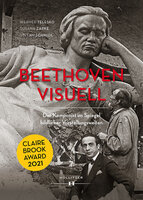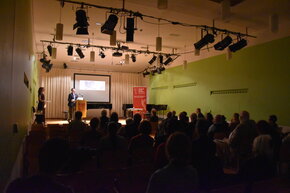- Scientific Team
- ZWF - Mission Statement
- Artistic Research at the MUK
- Annual theme
- ZWF events
- Current news
- Research projects
- Scientific Research Projects
- Overview Scientific Research Projects
- Beethoven
- The Austro-German Melodrama and its Film Music
- The Impact of Sound on the Screenplay, 1927—1934
- Deutschsprachige und anglophone Formenlehre der Nachkriegszeit
- The woman of my dreams
- Die Illusion der Freiheit
- ELEMU and the art of interaction
- European Landscapes
- Experiment Notation
- Film score for conveying ideology
- Gustav Mahlers Compositional Logic
- MUK History - Contemporary History
- Hellerau-Laxenburg
- Interdisziplinäre Mittelalterstudien
- It’s a Match!
- Cultural participation
- LSBTIQ* Bewegungen und Demokratie: Geschichte, Gegenwart und Zukunft
- MUK meets IFK
- Salon Différance
- Research on Dance Archives
- Theatre & Consciousness
- Urban Music Studies
- Hidden Paintings
- From Text to Performance: Literary Em-bodiment
- Wachau Myth
- Artistic Research Projects
- Overview Artistic Research Projects
- Archive of search
- Cabaret of Old News
- Composer/Performer Relations
- DANCR - an AI tool for dance research
- The vanishing of the archive
- The Art of Inclusion
- Dynamics of condensed systems
- Elementary Music Theatre
- Experiment Empathy in collaborative Improvisation
- Fiction and Research
- Franz Schubert — Der Akt des Dichtens in seiner musikalischen Darstellung
- Gender and violence
- Inter-university research network Elfriede Jelinek
- Art and politics
- The correlation between the gaze, the voice,...
- Notation and performance
- Suite Mixtur
- Transforming Instrumental Gestures
- Word.Music.Theatre
- Arts-based research (EEK)
- Overview EEK
- Artist in Residence Programm
- Artistic Research
- Moving images of Jewish culture / film and exile
- Carte blanche
- Didactics of Contempary Music and Composing
- Entente Musicale
- IGP and Community Music
- Jazz und seine Einflüsse aus anderen Musiktraditionen
- Method of Vienna
- Thinking music
- Operetta
- Poème électronique
- City and sound
- Viennese Original Sources
- vienna.composers@MUK
- Zeitgenössische klassische Musik & Jazz
- Scientific Research Projects
- Gender & Diversity
- Research Service
- Competence Centre Film | Film Music
- Joint Research Network E. Jelinek
- Teaching
Beethoven
BUCHPREIS! – New York, Claire Brook AWARD 2021
Die Publikation Beethoven Visuell. Der Komponist im Spiegel bildlicher Vorstellungswelten (Wien: Hollitzer 2020), von Werner Telesko (Österreichische Akademie der Wissenschaften), Susana Zapke (MUK) und Stefan Schmidl (MUK), wurde für das Jahr 2021 mit dem Claire Brook Award ausgezeichnet.
Der Preis wurde vom Graduate Center der City University of New York gestiftet und wird für herausragende Druckschriften für Musikikonografie und die Analyse der Beziehungen zwischen Musik und den visuellen Künsten verliehen. Die Jury nannte in ihrer Begründung für die Zuerkennung des Preises die innovativen Forschungsansätze der Publikation in der forschungsgeschichtlich bereits seit Längerem etablierten Beethoven-Ikonografie.
Das Werk von Telesko, Zapke und Schmidl unterscheidet sich von anderen Herangehensweisen an die Rezeption Beethovens zum einen durch die Einbeziehung unterschiedlichster visueller Medien, zum anderen durch eine Fokussierung auf die Natur, die materielle Umwelt und das Immaterielle als drei spezifische Themenbereiche der bildlichen Vorstellungswelten Ludwig van Beethovens vom 19. Jahrhundert bis in die Gegenwart.
Beethoven Visuell. Der Komponist im Spiegel bildlicher Vorstellungswelten, Werner Telesko, Susana Zapke, Stefan Schmidl (Wien: Hollitzer, 2020), 252 p. ISBN 978-3-99012-791-9
https://www.oeaw.ac.at/ihb/detail/news/the-claire-brook-award
https://brookcenter.gc.cuny.edu/2022/01/28/claire-brook-award-for-2021-bestowed-on-two-publications/
Über Claire Brook: https://jwa.org/encyclopedia/article/brook-claire
"The committee for the Claire Brook Award has met twice over the past weeks and we have decided to award two books equally this year: Werner Telesko et al, Beethoven Visuell and Michael Burden's With a Grace Not to Be Captured (Brepols). We liked both books and thought that BOTH should be awarded equally, because each of them is innovative in its own way. We were impressed how you found in the articles an interesting new angle in the interpretation of the reception of Beethoven in the visual media, although that topic has been dealt with many times in the past. With the Burden book we thought that he and his authors have made an innovative approach to the portraiture of dancers that is often neglected."
Publishing another book on the occasion of the 250th anniversary of the birth of Ludwig van Beethoven requires courage. Werner Telesko, Susana Zapke, and Stefan Schmidl found this courage and produced a remarkable book focusing on the reception of Beethoven in visual culture.
The three thematic complexes concern Beethoven in nature on the one hand, in his concrete material environment on the other hand, and finally in connection with immaterial values and sacred ideas. Within the framework of these three categories, the authors examined many media that have contributed to the formation of a visual and textual “exaggeration” so characteristic of the Beethoven phenomenon. Even if the image documents are the focus of the publication, it should always be clear that these are to be viewed in close historical and contextual relation to the literary and philosophical discourses on Beethoven.
In his essay, Werner Telesko deals with the broad topic of Beethoven’s connections with the natural environment and, above all, takes up the question according to the different picture types from an art-historical perspective, whereby it becomes clear that the philosophical and literary debates of the respective time influence the picture production and are thus able to explain the metaphors of nature as Beethoven’s central interpretive category. Susana Zapke focuses on locating Beethoven in the interior as a creative space of the genius that can be read allegorically in a variety of ways, which in turn functions as a complement to the outside space and to nature in the sense of the culture-nature discourse of the Enlightenment. The interior becomes a field of interpretation for the psychological physiognomy of the artist and his work, revealing bourgeois-influenced thinking and pictorial traditions of the respective cultural-historical epoch. Finally, Stefan Schmidl deals with the localization of the composer in the immaterial space and points to some little-known projections of Beethoven in the spheres of the unreal, sacred and timeless, whereby virtuality as a means of representing visualizations always pushes the boundaries of hallucination, the dream and the visionary touched again.
Internationales Symposium, Warschau 4.-5. April 2022
Beethoven - Father of Great Symphonism
Organisation:
Music Theory and Interpretation Department
The Krzysztof Penderecki Academy of Music in Krakow
The theme of Symposium comes directly from the main Festival idea. Apart from the usual Beethoven focus, this time it will be obvious to concentrate on the symphonic oeuvre growing out of the foundation made by the Master of Bonn. We imagine the possibility of elaboration on the symphonic genre itself, on its Beethovenian tradition, on multiple streams of the symphonic music in its national and genre varieties.
Wer war Ludwig van? Drei Denkanstöße
Publikation
![[Translate to English:] Wer… [Translate to English:] Wer…](/fileadmin/_processed_/2/f/csm_WerwarLudwigvan_Cover_10ee1f5f7e.png)
Über kaum einen anderen Komponisten ist so viel geforscht worden wie über Beethoven. Fest ins kulturelle Gedächtnis haben sich Vorstellungen des Komponisten als »grollender Titan«, als Genie oder als übernationale Größe eingeschrieben. Dabei hat jede Zeit ihre eigene Imagination von Beethoven: Die Gegenwart stößt sich kaum mehr an popkulturell-bunten Beethoven-Vorstellungen, während Beethoven um 1900 als Überwinder und Held Identifikationsfigur für Militarismus und Nationalismus war. Doch wie hängen diese Bilder mit jenem Pianisten und Komponisten zusammen, der 1792 nach Wien kam, in der Wiener Aristokratie bestens vernetzt war und gefördert wurde, und der im kulturellen Soziotop Wiens zur Zeit von Belagerung, Krieg und politischen Umbrüchen künstlerisch neue Wege suchte?
Beethoven visuell. Der Komponist im Spiegel bildlicher Vorstellungswelten
Buchpräsentation
Ludwig van Beethoven (1770–1827) gilt als Protagonist einer der wirkungsmächtigsten medialen Diskurse der Kulturgeschichte mit geradezu universeller Reichweite. Die Vorstellungen über den Komponisten selbst bzw. darüber, wofür er sinnbildlich stand und heute noch steht, haben zur Konstitution und Verstetigung seines Mythos in Musik, Literatur, Film und anderen visuellen Medien beigetragen.
Werner Telesko, Susana Zapke und Stefan Schmidl werfen mit Beethoven visuell ein neues Licht auf die beeindruckende "Ikonografie" des Komponisten: Beethoven in der Natur, in seiner materiellen Umwelt, aber auch in Verbindung mit dem Immateriellen bilden dabei die wichtigsten Themengebiete der bildlichen Vorstellungswelten.
Di 17.11.2020 19:00
Musiksammlung der Wien-Bibliothek im Rathaus
Loos-Räume, Bartensteingasse 9
1010 Wien
BEETHOVEN BEWEGT
Diskussion und (Ur-)Aufführung einer unvollendeten Revolutionsoper "Leonore Prohaska“ alias August Renz von L. v. Beethoven
Beethoven Bewegt: Die Ausstellung im Kunsthistorischen Museum Wien bringt Beethoven in Dialog mit KünstlerInnen wie Friedrich, Goya, Rodin, Horn, Baldessari und Sehgal.
Susana Zapke, Beethoven: Ein hellsehender Tonheroe und seine Verehrer, in: Andreas Kugler, Jasper Sharp, Stefan Weppelmann, Andreas Zimmermann (Hg.), Beethoven bewegt. Wien: Kunsthistorisches Museum, Hatje Cantz 2020, S. 27–31.
Susana Zapke und Thomas Macho diskutieren über Beethovens Auseinandersetzung mit der Geschichte der Offizierstochter Eleonore Prochaska, die unter dem Pseudonym August Renz im Jahr 1813 in die Freiheitskriege gegen Napoleon zog. Für König und Vaterland gefallen, als Heldenjungfrau gefeiert, spiegeln sich in dieser weiblichen Figur charakteristische mythische Diskurse des 19. Jahrhunderts.
Programm:
Schauspielmusik (Fragment) zu dem Drama von J. F. L. Duncker von Ludwig van Beethoven (1815)
Leitung: Wolfgang Dosch, Niels Muus
Leonore: Sepideh Eslambolchi
Krieger: Namil Kim, Jongmin Kim, André Aguir Angenendt, Muratcan Atam
Klavier: Rafael Salas Chia
Susana Zapke (MUK) und Thomas Macho (IFK) im Gespräch
Di 9.06.2020 19:00
Kuppelhalle
Kunsthistorisches Museum Wien
Maria-Theresien-Platz, 1010 Wien
Eintritt frei
Wer war Ludwig van?
Wiener Vorlesung anlässlich des Beethoven-Jahres 2020
Wer war Ludwig van Beethoven? – Die Frage scheint einfach zu sein, denn über kaum einen anderen Komponisten ist so viel geforscht, nachgedacht und geschrieben worden. Fest ins kulturelle Gedächtnis haben sich dabei Vorstellungen eingegraben, die Beethoven als „grollenden Titan“, als Genie oder als übernationale Größe beschreiben. Dabei hat jede Zeit ihre eigene Imagination von Beethoven: Die Gegenwart stößt sich kaum mehr an popkulturell-bunten Beethoven-Vorstellungen, während um 1900 Beethoven als Überwinder und Held Identifikationsfigur für Militarismus und Nationalismus war.
Eine Wiener Vorlesung, die der Frage nachgeht, wie diese Bilder mit jenem Pianisten und Komponisten zusammenhängen, der 1792 nach Wien kam, in der Wiener Aristokratie bestens vernetzt war und gefördert wurde, und der im kulturellen Soziotop Wiens zur Zeit von Belagerung, Krieg und politischen Umbrüchen künstlerisch neue Wege suchte.
Podiumsdiskussion mit Birgit Lodes, Universität Wien, Melanie Unseld, Universität für Musik und darstellende Kunst Wien (mdw) und Susana Zapke, Musik und Kunst Privatuniversität der Stadt Wien (MUK)
Moderation: Helmut Jasbar, Ö1
Mit Live-Musik Studierender der mdw und der MUK
Mi 11.3.2020 19:00
Volkshochschule Floridsdorf
Angerer Straße 14
1210 Wien
Eröffnung des Beethovenjahres 16. Dezember 2019 im Rathaus
Der Komponist Ludwig van Beethoven bildet neben Gustav Mahler einen zentralen Forschungsgegenstand des IWF. In Kooperation mit der Internationalen Gustav Mahler Gesellschaft (IGM) und dem Wien Museum sowie mit internationalen Kooperationspartnern werden neue erklärungsorientierte Forschungsansätze hinsichtlich Aufführungspraxis, Rezeptions- und Wirkungsgeschichte, Mythologisierung, urban impact und urbane Imagebildung am Institut entwickelt. Durch die Anbindung referentieller internationaler Forscher*innen auf den Gebieten sowohl der Mahler- als auch der Beethoven-Forschung wird die Verschränkung wissenschaftlicher und künstlerischer Ansätze als zentrale Aufgabe des IWF gewährleistet.
Beethoven im Gemeindebau
2020 feiert Wien den 250. Geburtstag Ludwig van Beethovens − der Komponist und Musiker ist aus der Wiener Kulturgeschichte nicht wegzudenken, er macht(e) Wien ein Stück zu dem, was es ist: Welthauptstadt der Musik. In Bonn geboren, übersiedelte Beethoven als 22-Jähriger nach Wien und sah sich seither selbst als „Wiener“. Ein guter Grund, um am 16. Dezember 2019 – dem wahrscheinlichen Geburtstag des Komponistenstars – mit einem fulminanten Fest unter dem Motto „Beethoven für alle!“ in das Jubiläumsjahr zu starten.
Mit Studierenden der Studiengänge Jazz und Musikalisches Unterhaltungstheater, dem Universitätslehrgang für Klassische Operette, sowie dem 1. Wiener Gemeindebauchor
Programm:
Bundeslied op. 122 [mit Solist*innen der MUK]
Ich liebe Dich WoO 123 [mit Solist*nnen der MUK]
Die Ehre Gottes aus der Natur op. 48/4
Konzept: Susana Zapke
Mo 16.12.2019
Wiener Rathaus, Festsaal
Lichtenfelsgasse 2, 1010 Wien
Eintritt frei
Anmeldung erforderlich!
In Kooperation mit der Kulturabteilung der Stadt Wien (MA 7).
![[Translate to English:] Stadt… [Translate to English:] Stadt…](/fileadmin/_processed_/c/4/csm_Stadt_Wien_Kultur_848958fe67.jpg)
Symposium und Publikation: Beethoven visuell: Der Komponist im Spiegel bildlicher Vorstellungswelten
Dienstag, 30. Oktober 2018, 13:00 – 18:00 Uhr
MUK.podium, Johannesgasse 4a, 1010 Wien
Ludwig van Beethoven (1770–1827) gilt als einer der wirkungsmächtigsten medialen Diskurse der Kulturgeschichte mit geradezu universeller Reichweite. Ein eintägiges Symposium des Instituts für Wissenschaft und Forschung der Musik und Kunst Privatuniversität in Kooperation mit dem Institut für kunst- und musikhistorische Forschungen (IKM) der ÖAW geht der spannenden Frage nach, wie die Präsenz von Vorstellungen Beethovens in der Natur, in das Interieur und in das Immaterielle bis heute zur Konstitution und Verstetigung des Mythos vom Komponisten in Musik, Film, Literatur und den visuellen Medien beigetragen hat.
Diese drei thematischen Schwerpunkte bilden die Grundpfeiler einer quantitativ und qualitativ beeindruckenden „Ikonografie“ des Komponisten. Zugleich fungieren sie aber auch als zentrale Sinnschichten im Werk sowie in der Deutung der Biografie Beethovens.
Das abschließende Konzert (ab 19:00 Uhr) findet in Kooperation mit der Beethoven Society for Music and Research statt.
Moderation: Univ.-Prof. Dr. Susana Zapke (MUK)
Vortragende: Univ.-Prof. Dr. Stefan Schmidl (MUK, ÖAW), Univ.-Doz. Dr. Werner Telesko (ÖAW), Univ-Prof. Dr. Susana Zapke (MUK)
Respondenten: Prof. William Kinderman Ph.D (University of Illinois), Prof.em. Dr. Thomas Macho (IFK), Prof.em. Dr. Jürg Stenzl (Universiät Salzburg)
Publikation W. Telesko, S. Zapke, S. Schmidl: Beethoven Visuell. Der Komponist im Spiegel bildlicher Vorstellungswelten, Wien 2020 (in Druck)
Ludwig van Beethovens musikalisches Werk begeistert Menschen bis heute. Maßgeblich für die weltweite Verehrung des bedeutenden Komponisten ist aber auch die Tatsache, dass Beethoven der Protagonist einer der wirkungsmächtigsten medialen Diskurse der Kulturgeschichte mit universeller Reichweite ist. Darstellungen Beethovens selbst und dessen, wofür er sinnbildlich stand und heute noch steht, haben maßgeblich zur Konstitution und Manifestierung seines Mythos in Musik, Literatur, Film und anderen visuellen Medien beigetragen.
Die vorliegende reich bebilderte Publikation wirft ein neues Licht auf die beeindruckende „Ikonografie“ des Komponisten: Beethoven in der Natur, in seiner materiellen Umwelt, aber auch in Verbindung mit dem Immateriellen bilden dabei die wichtigsten Themengebiete der bildlichen Vorstellungswelten.
Finanzierung: Kulturabteilung der Stadt Wien, MA 7
In Kooperation mit dem Wien Museum und mit Univ.-Prof. William Kinderman, Visiting Researcher der MUK Wien (2016/17), wird an der Errichtung einer Gedenkstätte im sogenannten Testamentshaus (Heiligenstädter Testament im 19. Wiener Bezirk) gearbeitet. Zum Beethoven-Jahr 2020 ist geplant, ein interaktives Museum aufzubauen. Hierfür werden Konzerte, Masterclasses und Produktionen von der MUK konzipiert und durchgeführt.
Zur Interpretation und zum Verständnis von Beethovens Werken werden an der MUK im WS 2016/17 und Sommersemester 2017 Seminare und Workshops unter der Leitung von W. Kinderman gemeinsam mit den Studiengängen für Tasteninstrumente und Streichinstrumente stattfinden. Im März 2017 findet ein Symposium mit dem Titel Utopian Visions and Visionary Arts statt.
Publikation: Utopian Visions and Visionary Arts
Die Ergebnisse des Symposiums Utopische Visionen und visionäre Kunst: Beethovens ‚Geistiges Reich’ – revisited im März 2017 sind im Verlag Der Apfel erschienen.
Symposium „Utopian Visions and Visionary Arts“, in Kooperation mit dem Wien Museum und dem Institut für Kulturwissenschaften in Wien (IFK)
Gastprofessor*innen:
Univ.-Prof. Dr. William Kinderman (University of Illinois, School of Music — Studienjahr 2016-17)
Flyer
Programm
Programm englisch
Beethoven-Gesprächskonzert mit William Andrew Kinderman
Samstag, 3. Juni 2017, 12.00 - 14.00 Uhr
Erkersaal, Musik und Kunst Privatuniversität der Stadt Wien, Johannesgasse 4a, 1010 Wien
Historisch trifft auf Modern: Kammermusik von Beethoven
Montag, 22. Mai 2017, 20.00 Uhr
Wiener Musikverein, Gläserner Saal/Magna Auditorium, Musikvereinsplatz 1, 1010 Wien
In Ludwig van Beethovens Œuvre nimmt sein kammermusikalisches Werk einen wichtigen Stellenwert ein. An diesem besonderen Konzertabend wird dem Publikum von den Studierenden der Musik und Kunst Privatuniversität der Stadt Wien ein musikalisches Highlight präsentiert: Im ersten Teil sind zwei Klaviertrios auf historischen Instrumenten in alter Stimmung zu hören, das berühmte Gassenhauer-Trio sowie das Klaviertrio op. 38, basierend auf dem Septett op. 20. Dieses bekannte Werk steht im zweiten Teil des Konzertes in der Originalfassung auf modernen Instrumenten auf dem Programm. Für das Publikum wird durch die unterschiedliche Instrumentierung der Schaffensprozess nachvollziehbar.
Der Beethoveninterpret und -forscher William Andrew Kinderman hält vor dem Konzert um 19.00 Uhr einen Einführungsvortrag im Steinernen Saal (Zählkarten am Veranstaltungstag an der Kassa des Wiener Musikvereins erhältlich).
Beethoven-Klavierabend mit William Kinderman: "Von Leidenschaft zur Verklärung"
Dienstag, 16. Mai 2017, 18:30 Uhr
Vivaldi-Saal im ÖJAB-Haus, Johannesgasse 8, 1010 Wien
Programm:
Ludwig van Beethoven (1770—1827)
Sonate pathétique c-moll op. 13
Grave — Allegro di molto e con brio
Adagio cantabile
Rondo. Allegro
Sonate Es-Dur op. 81a Lebewohl-Sonate
Lebewohl — Les adieux. Adagio — Allegro
Abwesenheit — L'absence. Andante espressivo
Wiedersehen— Le retour. Vivacissimamente — Poco andante
Pause
Sonate c-moll op. 111
Maestoso — Allegro con brio ed appassionato
Arietta. Adagio molto semplice e cantibile
William Kinderman, Klavier
Meisterklasse Klavier mit William Kinderman
Termine:
Fr, 12. Mai 2017, 10.00 - 17.00 Uhr
Sa, 13. Mai 2017, 10.00 - 16.00 Uhr
MUK.podium, Johannesgasse 4a, 1010 Wien
Kooperationspartner
Wien Museum (Musikergedenkstätte)
IFK
Universität Wien




![[Translate to English:]… [Translate to English:]…](/fileadmin/_processed_/5/b/csm_poster_B26_RGB_89459985a5.png)
![[Translate to English:]… [Translate to English:]…](/fileadmin/_processed_/b/e/csm_IWF_Beethoven_visuell_Buch_7c1c259d9e.jpg)
![[Translate to English:]… [Translate to English:]…](/fileadmin/_processed_/5/d/csm_Logo-Wienbibliothek-im-Rathaus_f3c0ac9b06.jpg)
![[Translate to English:]… [Translate to English:]…](/fileadmin/_processed_/c/e/csm_IWF_Beethoven_Leonore_dd6adf00ea.png)
![[Translate to English:]… [Translate to English:] KHM](/fileadmin/_processed_/8/f/csm_IWF_KHM_logo_Kunsthistorisches_Museum_Wien_d03e1913a1.jpg)
![[Translate to English:] ©Peter… [Translate to English:] ©Peter…](/fileadmin/mediafiles/images/IWF/IWF_Beethoven2020.PNG)









![[Translate to English:]… [Translate to English:]…](/fileadmin/_processed_/d/d/csm_IMG_1514_ef9801b113.jpg)